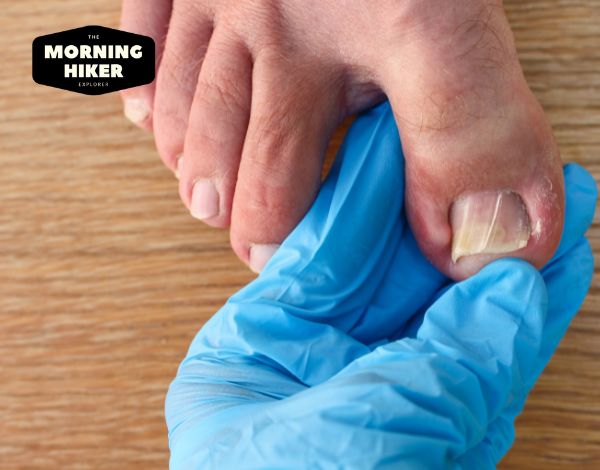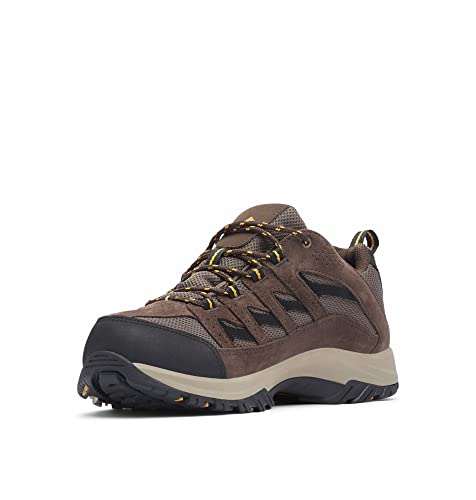Protect Your Feet: All About Hikers Toenail. Learn how to prevent and treat this common hiking injury.
Are you an avid hiker who loves to explore the great outdoors? If so, you may have experienced the pain and discomfort of hiker’s toenail.
This common condition can occur when your toenails are subjected to repeated trauma while hiking, leading to damage, blackening or even loss of the nail.
However, don’t let this discourage you from hitting the trails! With proper prevention and treatment methods, you can still indulge in your passion for hiking without worrying about painful toenail problems.
In this article, we’ll delve into everything you need to know about hiker’s toenail.
We’ll explore what it is and what causes it in the first place. You’ll discover how improper footwear, long nails or flattening of your arch can all contribute to this condition.
But most importantly, we’ll provide practical tips on how to prevent it from happening in the first place – so that you can enjoy your hikes without any worries.
This post contains some affiliate links to products that I use and love. If you click through and make a purchase, I’ll earn a commission, at no additional cost to you. Read my full disclosure here.
In This Article
Key Takeaways
- Toenail damage, black toenails, and toenail loss are common problems in hikers caused by wearing improper boots, long toenails, improper boot lacing, thick socks, and flattening of the arch.
- Prevention methods include buying the right boots, proper lacing techniques, cutting toenails regularly, changing out the boot insert, and buying appropriate socks. Using trekking poles and special hiking socks, keeping feet dry, and using powder can also help prevent hiker’s toenail.
- It is essential to cut toenails properly before hiking and to get boots that fit properly and are designed for the type of hiking you do.
- There are toenail fungus treatment supplements that can restore hurt and damaged nails.
What Is Hikers Toenail?
Hiker’s toenail, also known as discoloration and bruising of the toenail caused by repetitive trauma from hiking, is a common problem for hikers. The condition can be caused by improperly fitting shoes or socks and foot slippage. Hiking with a heavy backpack or on rocky terrain can exacerbate the problem.
Symptoms of hiker’s toenail include:
- Pain
- Swelling
- Discolorization
Prevention is key in avoiding hiker’s toenail.
Wearing well-fitting hiking shoes and moisture-wicking socks can help reduce friction between the toes and the front of the boots.
Trimming your toenails before a hike can prevent ingrown nails that may exacerbate the condition.
Taking breaks to massage your feet during long hikes can also help reduce foot slippage and prevent further damage to your nails.
If you do develop hiker’s toenail, treatment may involve seeing a podiatrist or natural nail loss.
Best Men’s Hiking Shoes For Bad Feet
- ADVANCED TECHNOLOGY: The Crestwood Waterproof Hiking Shoe features our Omni-TECH waterproof bootie construction, combined with our TECHLITE lightweight midsole, for long-lasting comfort with superior cushioning and high energy return.
- DURABLE HIKING SHOE: The perfect combination of high function and performance designed into a hiking shoe. This all-purpose hiker will deliver nimble and comfortable service.
- Waterproof & protection: Men hiking boots features waterproof synthetic leather and waterproof membrane construction that keeps your feet cool and dry.The rubber toe cap and the reinforced heel are designed for anti-collision,strenghthening the stability of the shoes which gives your ankle more protection.
- Durable & slip resistant: The sick rubber outsole is more stable,slip & abrasion resistant,and flexible response to various outdoor terrain. Rugged rubber outsole with Multi-Directional Traction (MDT) improves grip and provides durability. provides better protection in bad weather.
- ➤ Good Support & Comfortable Hiking Shoes — Support your ankles with comfortable ergonomics and a high-elastic sponge lining. Soft padded tongue and collar perfectly fit the ankle, absorb impact, and protect joints. Lightweight EVA midsole, strong toe cap, rear upper and arch support, you can enjoy safe, comfortable and stable trips or outdoor activities with the hiking & trekking shoes.
- ➤ UPGRADE Durable & Shockproof & Non-Slip Outsole — Upgrade MD+RB synthesis outsole with deep lugs design can provide reliable traction and grip even in complex terrains. The hiking shoes enhance the anti-slip performance by 50%. You will love them when you first time wear them and can’t wait to have more color.
- ADVANCED TECHNOLOGY: Columbia Men’s Crestwood Mid Waterproof Wide Hiking Boot features our lightweight, durable midsole for long lasting comfort, superior cushioning, and high energy return as well as an advanced traction rubber sole for slip-free movement on rough ground.
- HANDY FEATURES: Treacherous days out on the trail are comfortable and worry-free with this boot’s waterproof full-grain leather and mesh bootie construction and its durable mesh tongue for breathability.
Best Women’s Hiking Shoes For Bad Feet
- OMNI-TECH: Our proprietary technology provides air-permeable protection that’s waterproof and breathable, keeping mother nature’s elements out, at the same time allowing the inside to breathe, keeping you dry and comfortable no matter the conditions
- ANY TERRAIN / ANY WEATHER: A lightweight and durable waterproof shoe designed for multiple activities on the trail
- ADVANCED TECHNOLOGY: Columbia Women’s Newton Ridge Plus Waterproof Hiking Boot features our lightweight, durable midsole for long lasting comfort, superior cushioning, and high energy return as well as an advanced traction rubber sole for slip-free movement on rough ground.
- HANDY FEATURES: Treacherous days out on the trail are comfortable and worry-free with this boot’s waterproof full-grain leather and mesh bootie construction and its durable mesh tongue for breathability.
- 【Attention】—These hiking shoes maybe a little larger than the size you usually wear,so please choose a size smaller than what you usually wear. 【Breathable & Fashion】—The upper of hiking shoes are made of breathable knitted mesh fabric, super soft comfortable and wear-resistant, providing good breathability,the color matching design makes you look more fashionable.
- 【Waterproof and Soft Inner】—These trekking shoes are made of high-grade special materials, and the waterproof inner lining can prevent moisture from penetrating and can effectively wick away perspiration, keeping your feet dry and not stuffy; the soft insole makes your every step more easy and comfortable.
- ADVANCED TECHNOLOGY: The Newton Ridge Plus Waterproof Amped Hiking Boot features a seam-sealed construction, combined with our TECHLITE lightweight midsole, for long-lasting comfort with superior cushioning and high energy return.
- DURABLE HIKING BOOT: This women’s boot is inspired by classic mountaineering style. A durable mid cut waterproof hiker that provides great traction and comfort. This classic Columbia hiking boot, will deliver years of comfortable service.
- Rubber outsoles offer the optimal balance of traction and durability, with a responsive feel on unpredictable terrain.circular lug patterns provide grip during movement
- Removable insoles support the feet’s arches and not cause too much pressure and transfer weight over the ball of the feet.
Why Do My Toenails Hurt When Hiking?
Feeling discomfort in your toenails while hiking? It could be due to repetitive trauma from foot sliding in ill-fitting shoes or improper lacing techniques. Your toenails may also suffer from the accumulated weight of a heavy backpack, causing subungual hematoma.
To prevent pain and injury, it’s important to invest in proper footwear options that fit well and provide ample support for your feet. Additionally, trailside treatments such as toe care tips and stretching techniques can help alleviate discomfort during long hikes.
Make sure to trim your toenails regularly and wear moisture-wicking socks to avoid fungal infections. With these preventive measures, you can focus on enjoying the freedom of exploring nature without worrying about painful toenail problems.
Hikers Toenail: Reasons Hiking Is Hurting Your Toenails
With every step you take on your hiking adventure, your toenails may be suffering due to a combination of factors. Improper boot fit is a common cause of toenail damage, as tight shoes can lead to bruising and blackened nails.
Long toenails are another culprit, as they can rub against the inside of the shoe and cause irritation. Flattening of the arch can also contribute to toenail problems by allowing your foot to slide forward in the shoe, putting pressure on your toes.
Improper boot lacing and thick socks can also exacerbate these issues. It’s important to invest in proper footwear that fits well and offers support for your feet.
Regular toenail care is crucial, including keeping them trimmed and filing down any rough edges. Moisture management is also key – wearing moisture-wicking socks and using anti-fungal sprays or powders can help prevent fungal infections that can damage nails.
Additionally, investing in hiking accessories like trekking poles can help alleviate pressure on your toes while navigating tough terrain. Proper pain management techniques should be employed if you do experience toenail damage while hiking so that you don’t have to miss out on any future adventures.
Ways To Prevent Hikers Toenail
You can easily prevent toenail damage while hiking downhill by ensuring your boots fit properly, lacing them correctly, and wearing the right socks.
Proper footwear is essential to avoid hiker’s toe, so invest in a pair of high-quality hiking boots that provide ample support and comfort. Make sure they fit well, with at least half an inch of space between your toes and the front of the boot. Break them in before hitting the trail to avoid blisters or other foot injuries.
In addition to proper footwear, sock selection is also crucial for preventing hiker’s toenail. Opt for moisture-wicking hiking socks that keep your feet dry and comfortable throughout your hike.
- Moisture Wicking Fibers Keep Feet Dry with Ventilation Channels Engineered for Air Circulation and Moisture Control
- Arch Compression Provides Added Support and Stability
- Dri-tech Moisture Control fibers helps keep feet dry
- Full Cushion Foot for Added Comfort
Trim your toenails regularly before hitting the trail to prevent them from banging against the inside of your shoes while walking downhill. Finally, practice good foot hygiene by cleaning and drying your feet thoroughly after each hike to prevent fungal infections that can lead to further toenail damage.
By following these simple techniques, you can enjoy hiking without worrying about painful toenail problems.
How To Treat Hikers Toenail
If your hiker’s toe is causing discomfort, don’t hesitate to seek medical attention to prevent further damage or infection. Remember, an ounce of prevention is worth a pound of cure!
The following treatment options can help alleviate pain and promote healing:
1. Keep the affected area clean and covered with a bandage to protect it from dirt and germs.
2. Apply ice for 20 minutes on and 20 minutes off to reduce swelling and inflammation.
3. Take over-the-counter pain medications such as ibuprofen or acetaminophen to manage pain.
4. Rest your foot as much as possible, avoiding activities that may aggravate the injury.
The healing time for hiker’s toe varies depending on the severity of the injury, but typically takes several weeks or months. While home remedies can help relieve pain and promote healing, it’s important to address any underlying medical causes of toenail loss or damage through preventative techniques like wearing properly fitting boots, trimming toenails regularly, and using hiking poles for stability.
By taking proactive steps towards prevention and seeking prompt medical attention when necessary, you can enjoy all the benefits of hiking without having to worry about painful toenail problems.
When To See A Doctor
Seeking medical attention is crucial if symptoms such as severe pain, redness, swelling, discharge, neuropathy, or any condition that affects healing or circulation arise.
In the case of hiker’s toenail, it’s important to see a doctor if the toenail has fallen off or is loose and causing discomfort.
A podiatrist can provide treatment options such as laser therapy or topical medication to promote healing and prevent infection. Recovery time for hiker’s toenail varies depending on the severity of the injury and treatment received. It may take several weeks for a new nail to fully grow back.
Long term effects include misshapen nails or fungal infections if proper prevention methods are not taken in the future.
Frequently Asked Questions
How can using trekking poles prevent hiker’s toenail?
Using trekking poles can prevent toenail damage by reducing the pressure on your toes and feet. Combine this with proper footwear, regular toenail maintenance, choosing the right socks, stretching your feet, and getting foot massages to keep your feet healthy while hiking.
Are there any specific lacing techniques that can help prevent hiker’s toenail?
Lacing techniques can help protect your toes while hiking. Make sure your footwear choices fit properly and use toe protectors if needed. Select moisture-wicking socks and trim your nails regularly to prevent blisters and toenail damage.
Can hiker’s toenail lead to other foot problems besides fungal infections?
Improper footwear selection and lack of moisture control can lead to blisters, which may result in altered gait that can cause other foot problems. Proper socks and nail trimming are key for prevention.
Are there any natural remedies for preventing hiker’s toenail?
To prevent toenail damage while hiking, consider herbal remedies like tea tree oil and Epsom salt foot baths. Our #1 natural supplement recommendation is Fungus Elixir.
Proper footwear choices, diet changes, stretching exercises, and foot care routines can also help keep your feet healthy and pain-free.
Can hiker’s toenail be prevented by changing your hiking route or terrain?
Changing your hiking route or terrain may not prevent hiker’s toenail. Proper toenail trimming, foot hygiene, moisture management, and sock selection are vital. Hiking footwear that fits well is crucial for preventing this painful condition.
Before You Go
Remember, proper footwear, regular toenail trimming, and lacing techniques can go a long way in preventing this common issue.
However, if you do experience toenail damage or loss while hiking, don’t panic. There are effective treatment options available such as laser therapy.
It’s important to take care of your feet while enjoying the great outdoors. Hiking should be an enjoyable experience without having to worry about painful toenails.
By following these tips and seeking medical advice when necessary, you can continue to hike with confidence and comfort.
So put on those hiking boots and get ready for your next adventure!
Survival MD

Exclusive Report Reveals The Most Comprehensive Guide To Survival Medicine
- What to do when there is no doctor available
- How to make it without electricity
- Reattach a tooth using salt water
- How to improvise a splint from a plank, pillow, or rolled-up newspaper
- Safely dress a burn in food wrap or a plastic bag
- Powerful proven-to-work home remedies
- Water filtration basics
- How to make your own antiseptic and sanitizer
- And much more…














We are participants in the Amazon Services LLC Associates Program, an affiliate advertising program designed to provide a means for sites to earn advertising fees by advertising and linking to Amazon.com